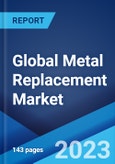Metal replacement refers to the substitution of metals with high-performance polymers, ceramics and composites. Some of the commonly used metal replacement materials include polycarbonates, polyamides, acrylonitrile butadiene styrene (ABS), thermoplastic polyester, fluoropolymers and polyacetals. In comparison to the traditionally used metals, they are lightweight and offer enhanced material performance, cost-effectiveness, thermal, acoustic, electrical and vibration insulation and corrosion and chemical resistance. They are also convenient to manufacture and can be molded into complex shapes. As a result, they find extensive application across various industries, including aerospace, defense, automotive, healthcare and construction.
Metal Replacement Market Trends
The increasing adoption of engineering plastics across industries is one of the key factors driving the growth of the market. Moreover, the widespread adoption of metal replacement in the aerospace and automotive industries is providing a thrust to the market growth. Metal replacing materials exhibit superior mechanical strength and heat resistance and are widely used for the manufacturing of connectors, under-the-hood components, reflectors and lighting sockets. They are also used for the production of lightweight and compact aerospace components that exhibit enhanced structural strength and durability. In line with this, the widespread adoption of polyphenylsulfone for medical and high-temperature applications is also contributing to the growth of the market. Additionally, the increasing utilization of metal replacement in residential and commercial construction projects is acting as another growth-inducing factor. These materials are utilized to substitute steel rods, concrete reinforcements and produce effective sewage systems. Other factors, including the increasing requirement for lightweight components across industries, along with extensive research and development (R&D) activities, are anticipated to drive the market toward growth.Key Market Segmentation
This research provides an analysis of the key trends in each sub-segment of the global metal replacement market report, along with forecasts at the global, regional and country level from 2023-2028. The report has categorized the market based on type and end use industry.Breakup by Type:
- Engineering Plastics
- Polyamide
- Acrylonitrile Butadiene Styrene (ABS)
- Thermoplastic Polyesters
- Polycarbonates
- Composites
- Glass Fiber Reinforced Plastic
- Carbon Fiber Reinforced Plastic
Breakup by End Use Industry:
- Automotive
- Aerospace and Defense
- Construction
- Packaging
- Consumer Goods
- Healthcare
- Transportation
Breakup by Region:
- North America
- United States
- Canada
- Asia-Pacific
- China
- Japan
- India
- South Korea
- Australia
- Indonesia
- Europe
- Germany
- France
- United Kingdom
- Italy
- Spain
- Russia
- Latin America
- Brazil
- Mexico
- Middle East and Africa
Competitive Landscape
The competitive landscape of the industry has also been examined along with the profiles of the key players being A.K. Industries Inc., Asahi Kasei Corporation, Aztec Plastic Company, BASF SE, Celanese Corporation, China Jushi Co.Ltd., DOMO Chemicals GmbH, DuPont de Nemours Inc., SGL Carbon SE, Solvay S.A., Toray Industries Inc. and Victrex plc.Key Questions Answered in This Report
1. What was the size of the global metal replacement market in 2022?2. What is the expected growth rate of the global metal replacement market during 2023-2028?
3. What are the key factors driving the global metal replacement market?
4. What has been the impact of COVID-19 on the global metal replacement market?
5. What is the breakup of the global metal replacement market based on the type?
6. What is the breakup of the global metal replacement market based on the end use industry?
7. What are the key regions in the global metal replacement market?
8. Who are the key players/companies in the global metal replacement market?
Table of Contents
Companies Mentioned
- A.K. Industries Inc.
- Asahi Kasei Corporation
- Aztec Plastic Company
- BASF SE
- Celanese Corporation
- China Jushi Co.Ltd.
- DOMO Chemicals GmbH
- DuPont de Nemours Inc.
- SGL Carbon SE
- Solvay S.A.
- Toray Industries Inc.
- Victrex plc
Methodology

LOADING...
Table Information
| Report Attribute | Details |
|---|---|
| No. of Pages | 143 |
| Published | November 2023 |
| Forecast Period | 2022 - 2028 |
| Estimated Market Value ( USD | $ 167.8 Billion |
| Forecasted Market Value ( USD | $ 275.2 Billion |
| Compound Annual Growth Rate | 8.6% |
| Regions Covered | Global |
| No. of Companies Mentioned | 12 |









